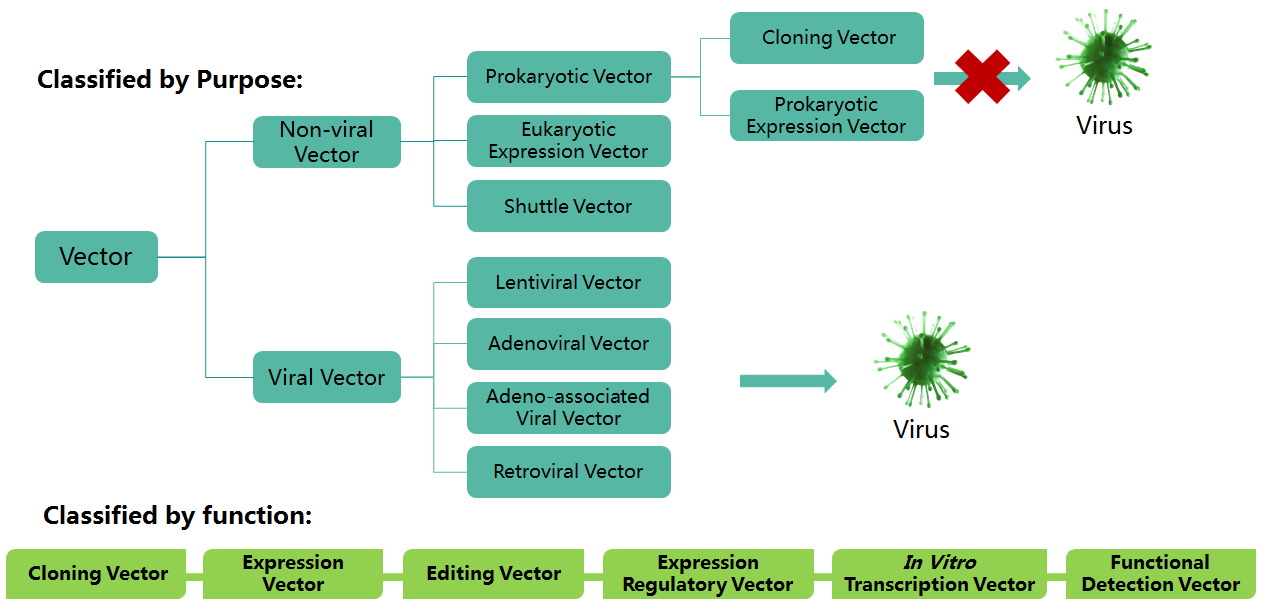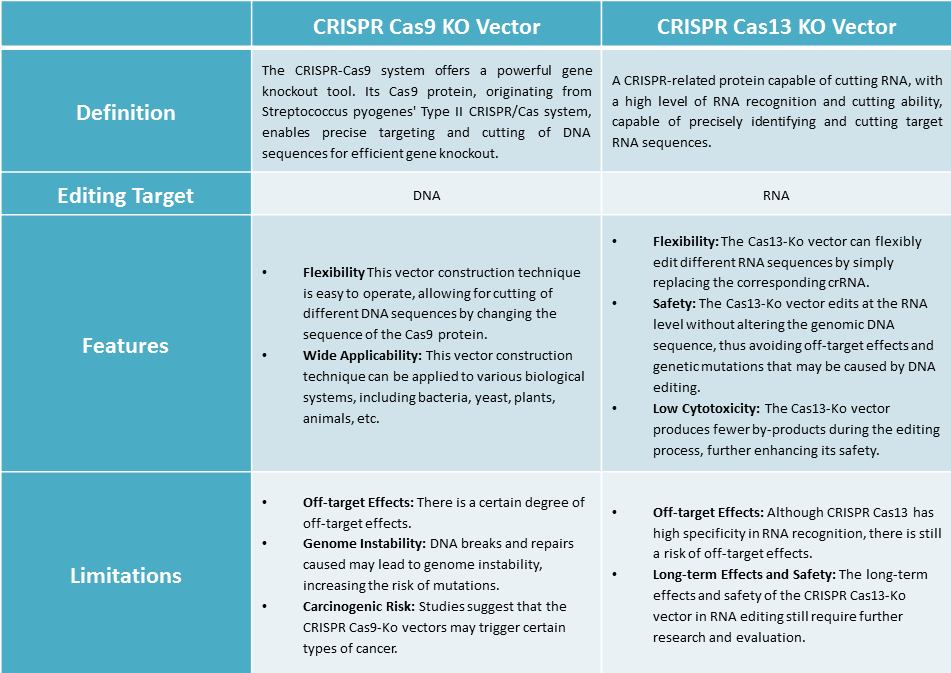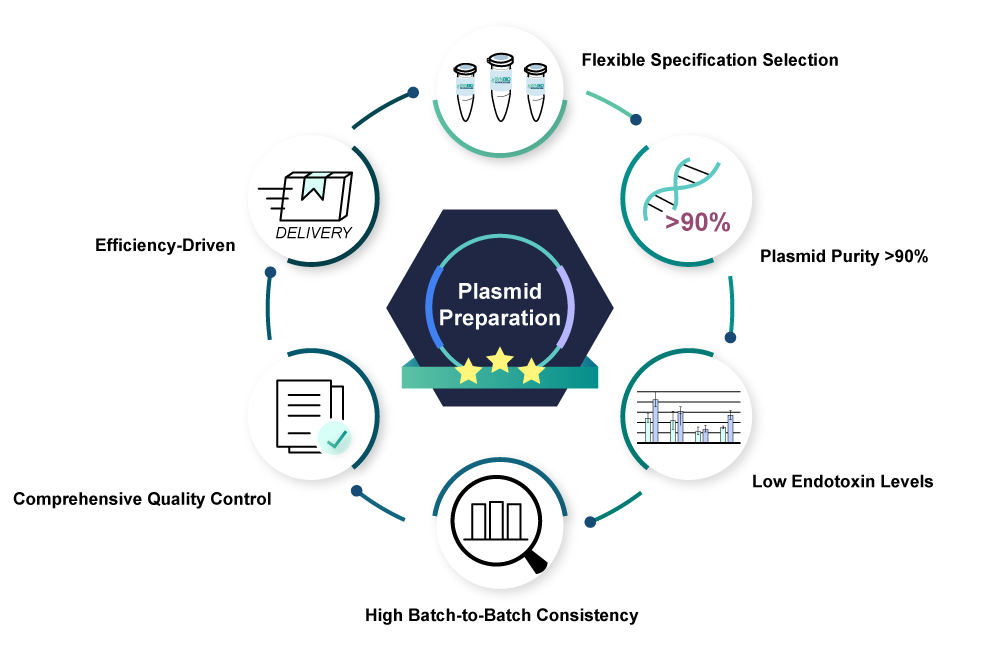Small plasmids, big impact!
With the power to transfer and manipulate genetic material with remarkable precision and efficiency, plasmids have revolutionized research in the life science field.
What Are Plasmids?
Plasmids are essential vessels for the transfer and expression of foreign genes. By safely and effectively delivering genes into target cells, plasmids pave the way for limitless possibilities in fields such as genetic engineering, gene therapy, synthetic biology, and many more.
Most plasmids are DNA-based, with a minority being RNA-based. Natural DNA plasmids typically feature covalently closed, circular molecular structures and are characterized by high molecular weight alongside few unique restriction enzyme sites.
Natural plasmids can be transformed into versatile plasmid vectors through a series of engineering modifications. These modifications often include:
-
Sequence Optimization: Enhancing plasmid sequences through mutation or recombination techniques improves replication efficiency and stability in host cells.
-
Element Additions: Incorporating various genetic elements such as promoters, terminators, and selection markers (e.g., antibiotic resistance genes) help boost functionality and expression efficiency.
-
Multiple Cloning Sites (MCS): Designing and inserting MCS provides multiple unique restriction enzyme sites, facilitating convenient and flexible insertion of foreign genes.
-
High Copy Number Plasmids: Modifying plasmids to increase their copy number in host cells enhances the expression of foreign genes.
Depending on their use and function, plasmid vectors can be categorized into various types, each with unique characteristics and applications.

Comparison of Expression Vectors
Conventional gene expression vectors, recombinant protein expression vectors, non-coding RNA expression vectors, and antibody protein expression vectors are compared as follows:
Gene Expression Vectors
-
Target Genes: Genes of unknown function or specific sequences.
-
Features: Equipped with selection markers or reporter gene elements for gene subcellular localization or overexpression/restoration.
-
Limitations: Immunogenicity issues where the host cells may produce an immune response leading to vector clearance or cell death.
-
Applications: Functional gene research.
Recombinant Protein Expression Vectors
-
Target Genes: Gene sequences encoding target proteins.
-
Features: Design gene sequences that are not naturally existing, including specific tagging elements for protein selection and purification with diverse expression systems available.
-
Limitations: High costs from vector construction to protein purification, scale-up challenges, and some proteins are difficult to express efficiently.
-
Applications: Gene and protein function research, protein structure and interaction studies.
Non-coding RNA Expression Vectors
-
Target Genes: Various types, such as miRNA, siRNA, lncRNA, or circRNA.
-
Features: Specificity in targeting specific genes or RNA molecules with potential for therapeutic use in diseases caused by abnormal gene expression.
-
Limitations: Immune responses, non-specific regulation, and stability issues.
-
Applications: Gene expression regulation and research into the biological functions of non-coding RNA.
Antibody Protein Expression Vectors
-
Target Genes: Gene sequences encoding specific antibodies, including heavy and light chain DNA fragments.
-
Features: High flexibility for expressing various types of antibodies; advanced applications like multi-gene co-expression and fusion protein expression possible.
-
Limitations: Unstable expression efficiency; challenges in controlling activity; high purification costs; safety concerns with host cells.
-
Applications: Antibody function research and drug development.
Comparison of Editing Vectors
The design and construction of editing vectors require specialized knowledge and skills to ensure precision and efficiency. They are primarily divided into CRISPR Cas9 and CRISPR Cas13 knockout vectors:

Recombinant plasmid construction
The construction of recombinant plasmids is a crucial technology in the field of molecular biology and genetic engineering, enabling researchers to create recombinant plasmids with specific functions by inserting specific genes or DNA fragments into plasmid vectors. This technique is important for gene cloning, gene expression, gene editing, and the research and development of genetically modified organisms.

The whole plasmid construction process requires the mastery of a few skills, such as the design of PCR primers, the selection of enzyme cutting sites, and the optimization of conditions for ligation reactions. Additionally, it is crucial to focus on standardization and accuracy during experimental procedures to guarantee the functionality and desired outcomes of the created recombinant plasmids.
FAQ
Low recombination efficiency?
Optimize enzymatic digestion and ligation conditions, such as adjusting the digestion time, temperature, and enzyme amount. Or, try using different ligases.
Loss or incorrect insertion of foreign gene fragments?
Check if the digestion sites are correct to avoid using non-specific enzymes and optimize ligation conditions to ensure the correct insertion of foreign gene fragments into the plasmid vector.
Instability of recombinant plasmids?
Incorporate stability sequences into the plasmid vector, such as replication origins and selection markers, to enhance the stability of recombinant plasmids.
Low or no expression of the target gene?
Check if the promoter and terminator are correctly positioned, confirm that the target gene has not mutated or framed, and consider using enhanced expression systems like inducible promoters or strong promoters.
The key to the preparation of plasmids is to ensure high purity and stability, and the whole process needs to be fine-tuned.

FAQ
Low plasmid copy number?
Increase the volume of bacterial liquid used for extraction while reducing the elution volume or switch to a high-copy number vector with equivalent functionality.
Insufficient lysis?
Consider reducing the amount of bacterial mass or increasing the amount of lysis buffer. Ensure the bacterial cells are fully suspended and remove any excess bubbles.
Residual ethanol?
Increase the washing steps, use high-purity ethanol, and ensure thorough drying.
Inaccuracies or mutations in the DNA sequence?
Utilize high-fidelity polymerases for PCR amplification and regularly sequence the plasmids to confirm their accuracy.
Synbio Technologies provides customers with comprehensive, one-stop solutions for vector design, optimization, and construction. Our team of experts provides comprehensive plasmid DNA preparation services to support all your precise research needs. We ensure that all our synthesized plasmids are ofhigh quality, free of animal derivatives,and have low endotoxin content. Whether you need plasmids for research in transfection, antibody preparation, vaccines, or gene therapy applications, Synbio Tech has your back.

It's noteworthy that our high throughput gene editing vectors offer an unparalleled solution for your genetic engineering needs with their extensive species coverage and diverse editing capabilities. These vectors are suitable for biological research, disease treatment, agricultural biotechnology, and more. Our vectors are tailormade to meet all your specific research needs.
Join our community of scientists who trust Synbio Technologies to accelerate their R&D pipelines and make groundbreaking discoveries in the life sciences!
Reference
Marie, Corinne, and Daniel Scherman. "Antibiotic-Free Gene Vectors: A 25-Year Journey to Clinical Trials." Genes 15.3 (2024): 261.
 DNA Synthesis
DNA Synthesis Vector Selection
Vector Selection Molecular Biology
Molecular Biology Oligo Synthesis
Oligo Synthesis RNA Synthesis
RNA Synthesis Variant Libraries
Variant Libraries Genome KO Library
Genome KO Library Oligo Pools
Oligo Pools Virus Packaging
Virus Packaging Gene Editing
Gene Editing Protein Expression
Protein Expression Antibody Services
Antibody Services Peptide Services
Peptide Services DNA Data Storage
DNA Data Storage Standard Oligo
Standard Oligo Standard Genome KO Libraries
Standard Genome KO Libraries Standard Genome Editing Plasmid
Standard Genome Editing Plasmid ProXpress
ProXpress Protein Products
Protein Products
























